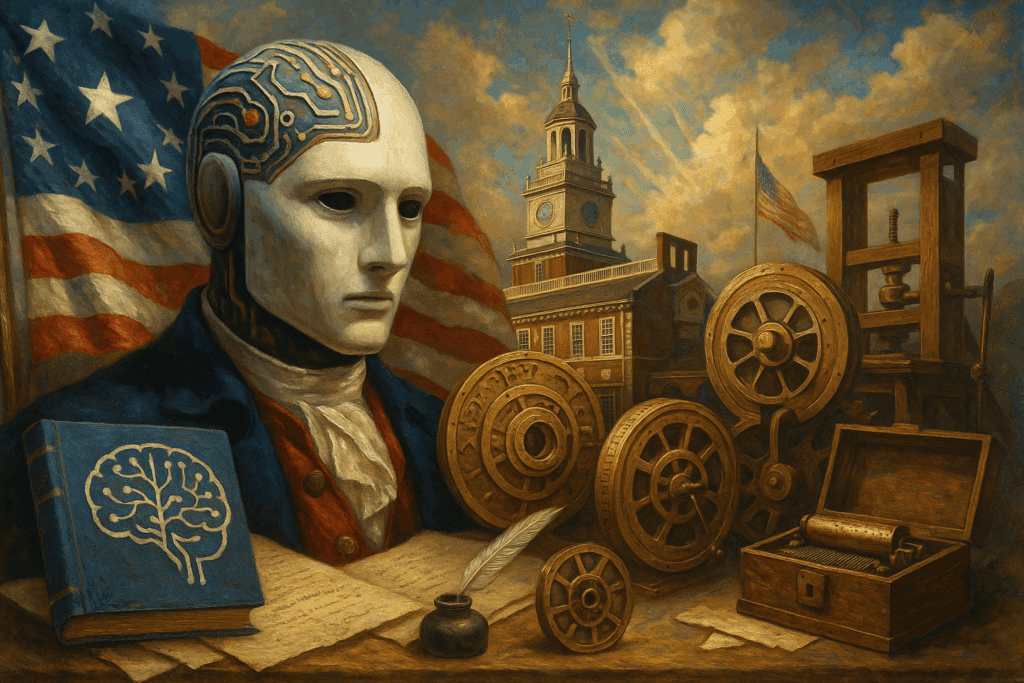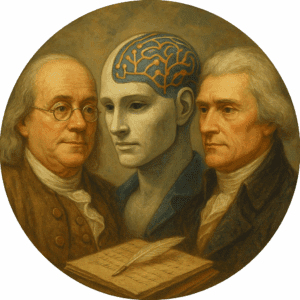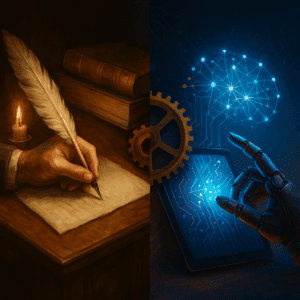The Origins of AI, Hidden in the Minds and Machines of 1776
Before machine learning and algorithms, there were minds, mechanisms, and methods that mirrored the very essence of AI. This is the untold story of artificial intelligence in the age of independence.
AI Isn’t New. It’s Just Been Upgraded.
When we think of artificial intelligence, we often imagine sleek interfaces, robotic voices, and machine learning models churning through data. But step back, and you’ll see something deeper: AI is about replicating aspects of human intelligence—decision-making, prediction, automation, and knowledge scaling.
And in 1776, those goals were already in motion.

Photo by: Vengo AI
Analog Intelligence in the Age of Revolution
- The Printing Press: Mass Replication of Human Thought
Though invented centuries earlier, the printing press was a vital engine of the American Revolution. It enabled the mass reproduction of pamphlets, declarations, and philosophical arguments. In essence, it was the first system to automate the distribution of “intelligence.” Much like AI scales human input today, the press scaled ideas then. - Cipher Wheels and Codebreaking: Pattern Recognition in Action
During the war, the use of encrypted messages and hidden codes was widespread. The process of encoding and decoding these messages required logic, pattern recognition, and strategic thinking—core pillars of modern AI systems. - Navigation and Mechanical Clocks: Early Predictive Modeling
Revolutionary-era ships used sextants, tide tables, and precision timekeeping to chart unknown territory. These tools combined observational data and mathematical rules to predict future positions—primitive, yet powerful examples of human-augmented forecasting. - Automata and Music Boxes: Pre-Programmed Logic Machines
Mechanical dolls and musical devices were marvels of their time. They ran on levers, gears, and cams—early forms of “programmed” behavior. While they didn’t learn or adapt, they demonstrated how logic and structure could simulate life-like responses. - The Human Brain as the Original Neural Net
Thinkers like Benjamin Franklin and Thomas Jefferson weren’t using silicon, but they were processing vast amounts of information from books, experiments, and conversation. They observed, reasoned, predicted, and acted. Our current AI models are built in their image—just faster and less philosophical.

Photo by: Vengo AI
A Hidden Truth
The ideals of 1776—freedom, self-determination, and progress—were powered by tools of the time that mirrored the aims of today’s AI: expand the reach of human intelligence and create systems that can think alongside us.
AI didn’t start with computers. It started with curious people asking, “Can this process be replicated? Can this knowledge be preserved? Can this decision be automated?”
The methods were mechanical. The ambition was revolutionary.
Why It Matters Today
Recognizing AI’s roots in our past helps strip away the mystery and fear surrounding it. It reminds us that:
- Innovation is a constant, not a recent invention
- Our tools may evolve, but our intentions remain familiar
- Understanding old systems can help us guide new ones with wisdom

Photo by: Vengo AI
A Revolution of Thought
As we celebrate July 4th, we honor the birth of a nation. But we can also honor the birth of ideas—ideas that aimed to extend human capability beyond the body and brain.
Artificial intelligence didn’t begin in a lab. It began wherever people asked, “How can I think beyond myself?”
And that question is just as revolutionary today as it was in 1776.
